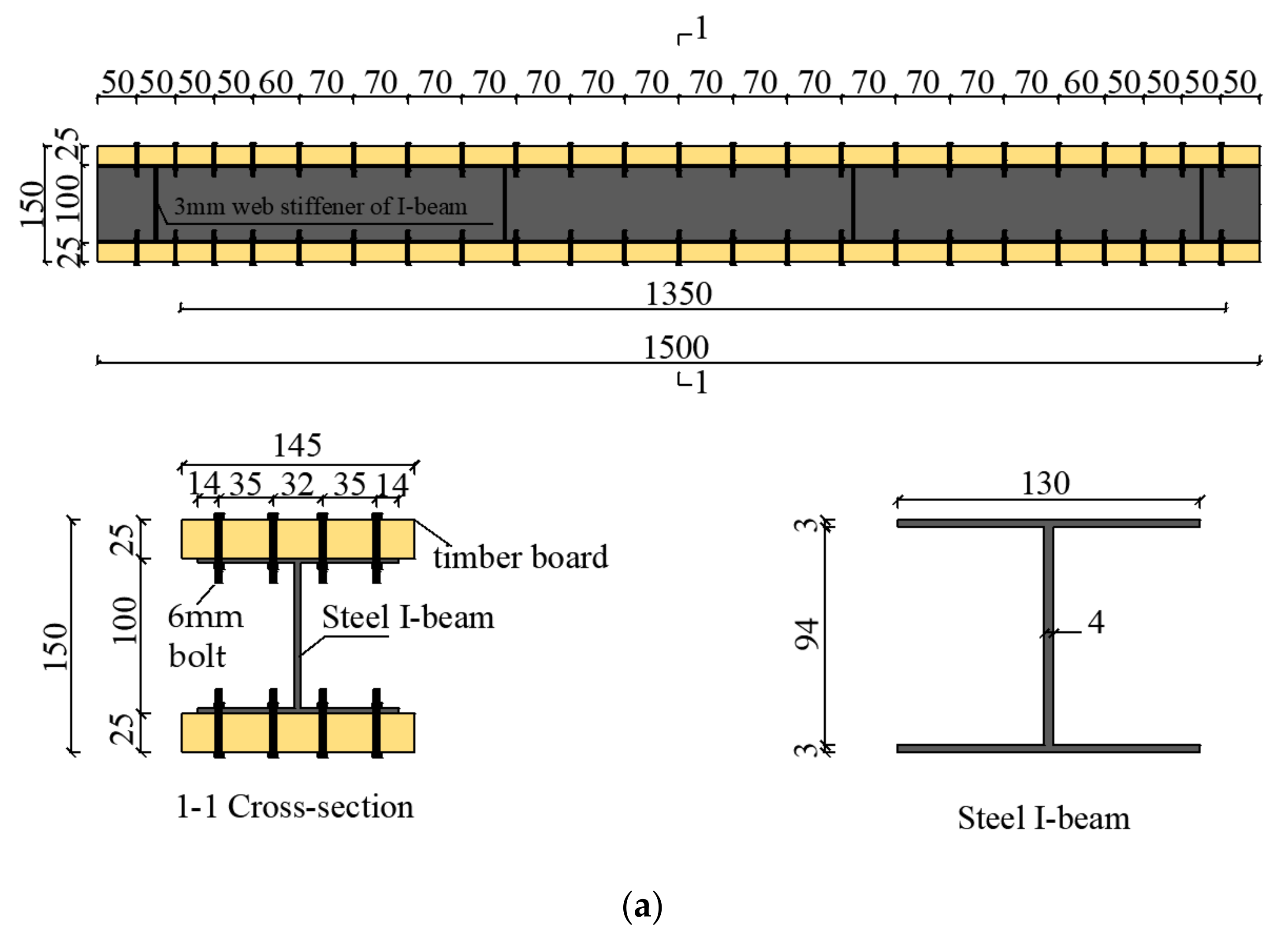2.4.2. Composite Coefficient Method
The TSC beams with a partial shear connection slip at the intersection of the timber board and steel beam during bending and no longer satisfy the flat section assumption. Therefore, in order to predict the deflection and flexural load capacity of TSC beams in normal use, following the research of Jingquan Wang et al. [
18], this paper uses the combined coefficient method to calculate the flexural stiffness of TSC beams while considering the slip effect. The calculation method and formula of the elastic limit flexural bearing capacity of the composite beam are proposed, which satisfy the following basic assumptions: (1) both timber and steel are ideal linear elastic bodies; (2) a bolt offers a good anti-lifting effect, and the timber board has the same curvature as the I-beam; (3) after slip occurs, both the timber board and the I-beam satisfy the assumption of a plane section; (4) the flexural rigidity of the partially shear-connected composite beam lies between the fully composite connection and the non-composite connection.
The composite coefficient method is an interpolation method based on the case of shear connectors, and the expression of its effective stiffness is as follows:
where
is the elastic modulus of the timber, as shown in
Table 2,
is the moment of inertia of the upper and lower timber board sections,
is the modulus of elasticity of steel as shown in
Table 3,
Is is the moment of inertia of the I-beam section, and
is the composite coefficient.
- (1)
No-shear connection composite coefficients
The composite beam without combined action has no shear force transmission at the composite interface, and both the timber board and the I-beam are bent independently; hence, the composite coefficient can be considered to be 0 ().
- (2)
Full-shear connection composite coefficients
The effective stiffness of the fully shear-connected composite beam is calculated as follows according to the equivalent section method [
18]:
The full shear connection composite coefficient is
- (3)
Composite coefficients of partial shear connections
The degree of composite connection is related to the shear stiffness of the shear connectors, and the shear stiffness is in turn related to the number of bolts and the cross-sectional area of the shear connectors. Following William’s [
19] and Nie’s [
20] research, the square-root interpolation method of the ratio of the number of bolts (single bolt cross-sectional area and material properties are the same) was used to calculate the composite coefficient of partial shear connections in this study.
where
is calculated according to the following formulas:
where
and
are the number of bolts for full shear connections and partial shear connections, respectively,
is the composite beam interface shear force,
is the ultimate shear design bearing capacity of a single bolt,
is the area of the cross-section over the width of the shear plane of the timber board (
),
is the cross-sectional area of the I-beam flange (
),
is the bolt diameter, and
is the design value of the shear strength of the bolt, shown in
Table 4.
- (4)
Calculation model of elastic limit state load-carrying capacity and mid-span deflection
Composite beams with partial shear connections produce slip at their interface [
20,
21,
22,
23], where the stresses on the surface of the timber board and those on the surface of the I-beam are not equal, resulting in different strains on the interfacing upper and lower surfaces, which can be defined as slip strain. Therefore, the strain of a partial shear connection can be divided into the strain generated by the full shear connection and the superposition of the strain generated by the slip, the calculation model of which is shown in
Figure 4, where
and
are the cross-sectional areas of the timber board and the cross-sectional area of the I-beam, respectively,
,
, and
are the timber board slip strain, I-beam slip strain, and total slip strain, respectively, and
is the yield strain of the I-beam. The ultimate elastic flexural load capacity of the partially composite beam is
where
is the flexural capacity of fully composite beams,
is the additional bending moment caused by the slip strain of the timber board,
is the additional bending moment due to slip strain in the I-beam, and
is the additional bending moment due to slip strain.
According to Nie’s definition of slip strain [
20,
24,
25], if
is the additional curvature generated by the slip strain, the expression for the slip strain
can be derived as follows:
The slip strains of the timber board and the I-beam are
According to
Figure 4, the additional bending moments generated by the slip strain of the timber and the I-beam are
Combining Equations (11)–(17) yields
Therefore, the equation for the elastic flexural load capacity of the partially shear- connected composite beam is as follows:
In this case, the moment of the fully shear-connected composite beam can be calculated using the converted section method as follows:
where
is the yield strength of the steel,
is the ratio of the modulus of elasticity of steel to the modulus of elasticity of timber, and
.
The test value of the elastic ultimate bending moment of the combined beam can be calculated according to the following formula:
where
is the test yield load of the composite beam, and
is the distance between the loading point and the proximal support.
On the basis of the research of Ji [
26] and Wang [
27], the composite beam deflection in the normal use phase can be carried out according to the method of structural mechanics and calculated according to the following equations:
where
is the theoretical yield load of the combined beam,
is the calculated span of the combined beam (see
Table 1), and
is the elastic limit theoretical bending moment value.




















